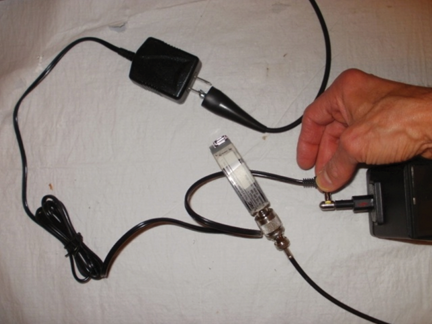Special simulator characteristics are needed
Measuring high voltage breakdown has many uses including tracking down the cause of equipment failure and ascertaining compliance to safety standards. Some ESD simulators can be used to measure DC breakdown voltage and have the advantage that they can measure breakdown to voltages in excess of 10,000 volts. Not all ESD simulators can do this and the special characteristics required are discussed and an example is given of how this method was used to track down an equipment problem.
Figure 1 shows the details of measuring the breakdown voltage of a small AC plug style transformer of the type often used with small electronic equipment. In this case, a Fischer F-65 current probe was used to measure the waveshape of the breakdown current, but this is not necessary to measure breakdown voltage.

Many ESD simulators work by charging up a storage capacitor, often on the order of 150 pF, to the desired high voltage and then switching the charged capacitor to the tip of the simulator. Unfortunately, ESD simulators that work this way cannot be used to measure breakdown voltage accurately and many of them have digital controls that also complicate matters. What is needed is a simulator that keeps the storage capacitor connected to the tip at all times and charged through a low-current, high voltage power supply.
The KeyTek MiniZap ESD simulator by Thermo Scientific is such a device. The storage capacitor is connected to the tip at all times and is charged by a low current, high voltage supply. The digital display is actually a voltmeter reading the tip voltage in real-time. The MiniZap’s analog controls (read as “knobs”) facilitate the breakdown voltage measurement.
The method is as follows:
- Connect the two nodes for the breakdown measurement between the tip of the MiniZap and its ground cable.
- Using air discharge mode, slowly raise the voltage setting of the MiniZap, remembering that the display on the MiniZap is actually reading the DC voltage stress being applied to the circuit or device under test.
- At some point, the MiniZap fires and turns off the high-voltage supply, signaling that a breakdown has occurred.
- The last reading on the display just before the MiniZap fired is the breakdown voltage of the circuit or device under test.
Figure 2 shows another example of a breakdown test on another small AC plug-style transformer. It is probably best not to have your fingers on the circuit during the actual test, lest you measure your breakdown voltage.

Using an ESD simulator, like the KeyTek MiniZap, one can measure breakdown voltage up to 15,000 Volts. If you don’t have an outright breakdown but just a leaky path, you will notice the device will load down the reading on the MiniZap, possibly making it impossible to reach the desired voltage.
Here is an example of how measuring breakdown voltage this way proved useful and time saving. I was working on a small embedded controller that used an electromechanical relay to operate a 240 VAC 60 Hz motor that rotated a sizable drum. The problem was that when the equipment was subjected to a 6 kV ringwave lightning surge test, the processor IC was often destroyed (burnt to a crisp).
The processor IC controlled a discrete transistor that operated the electromechanical relay, which in turn applied the 240 VAC mains to the motor, so I suspected a breakdown of the relay. I connected a MiniZap on the test bench from the contacts of a relay to its coil and slowly raised the voltage. The relay was rated at 6 kV, but at 5200 to 5400 Volts breakdown occurred between the coil and contacts! So, the relay was not meeting its published specifications and was allowing the lightning surge to be applied directly to the processor circuit with predictable results.
Summary
Some, but not most, ESD simulators can be used to measure high voltage breakdown in circuits and devices. The KeyTek MiniZap is one such device. The MiniZap will measure breakdown voltages to 15,000 Volts, probably more than most users require.
Equipment used in this Technical Tidbit:
- Thermo Scientific KeyTek MiniZap Electrostatic Discharge Simulator
